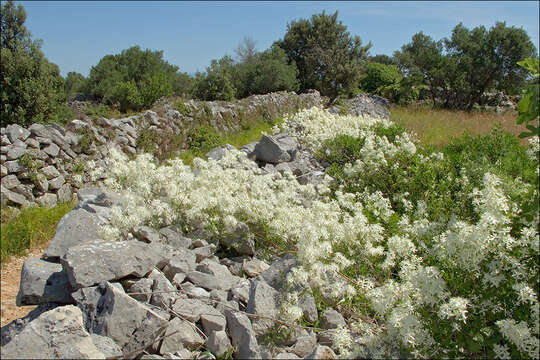Clematis-flammula_8

Description:
Clematis flammula L.Fragrant Virgin's Bower, Fragnant Clematis, DE: Brennende Waldrebe, Mandel-WaldrebeSI: diei srobotDat.: June 24. 2010Lat.: 44.36790 Long.: 14.78121Code: Bot_431/2010_IMG0969Habitat: Semi ruderal ground of abandoned fields near a village; on ground and stony walls; calcareous, skeletal ground; almost flat terrain; full sun, dry place; elevation 45 m (150 feet); average precipitations ~ 900 mm/year, average temperature 12-14 deg C, sub-Mediterranean phytogeographical region.Substratum: stony soil.Place: Next to the trail from village Olib to St. Nikola church; island Olib, Kvarner bay, Adriatic Sea, Croatia EC.Comment: Clematis flammula is one of my favorites among Mediterranean plants. It is a poisonous woody vine climbing sometimes up to a few meters high and to some extent visually similar to well-known and very common old man's beard (Clematis vitalba). But Clematis flammula flowers incomparably more abundantly. If it has no other plants or stony walls to climb on, it will climb on itself, forming a large 'bushes' fully covered by white flowers when in bloom. The plant is spreading around a wonderful, sweet smell on almonds, which gorgeously blends with, memorable by itself, 'Mediterranean' scent of sea-water, salt and other Mediterranean plants full of pungent aromatic oils. I have had a great luck to visit many other ocean and sea shores of four continents of this world, but, to my experience, nothing can compare to this experience of Mediterranean during late spring time, when everything it thriving vigorously, before dog days and flood of tourists makes the region much less attractive.Clematis flammula is rare in Slovenia. One can find it only in the warmest (during summer) valley of the country in Trako-Komenski Karst region near Brestovica village in southwest Slovenia. Another place where it grows is known on just the opposite side of the country in east Slovenia near town Ptuj (Ref. 5). On Adriatic Sea islands the plant is common. Ref.:(1) A. Martini et all., Mala Flora Slovenije (Flora of Slovenia - Key) (in Slovenian), Tehnina Zaloba Slovenije (2007), p 135. (2) I. Schnfelder, P. Schnfelder, Kosmos Atlas Mittelmeer- und Kanarenflora, Kosmos, (2002), p 44.(3) R. Domac, Flora Hrvatske (Flora of Croatia) (in Croatian), kolska Knjiga, Zagreb (1994), p 99.(4) M. Blamey, C. Grey-Wilson, Wild Flowers of the Mediterranean, A & C Black, London (2005), p 51.(5) N. Jogan (ed.), Gradivo za Atlas flore Slovenije (Materials for the Atlas of Flora of Slovenia), CKSF (2001), p 112.
Included On The Following Pages:
- Life (creatures)
- Cellular (cellular organisms)
- Eukaryota (eukaryotes)
- Archaeplastida (plants)
- Chloroplastida (green plants)
- Streptophyta
- Embryophytes
- Tracheophyta (ferns)
- Spermatophytes (seed plants)
- Angiosperms (Dicotyledons)
- Eudicots
- Ranunculales (Red Columbine)
- Ranunculaceae (buttercup family)
- Clematis (Traveller's Joy)
- Clematis flammula (fragrant clematis)
This image is not featured in any collections.
Source Information
- license
- cc-by-nc-sa
- copyright
- Amadej Trnkoczy
- photographer
- Amadej Trnkoczy
- original
- original media file
- visit source
- partner site
- Flickr Group
- ID


